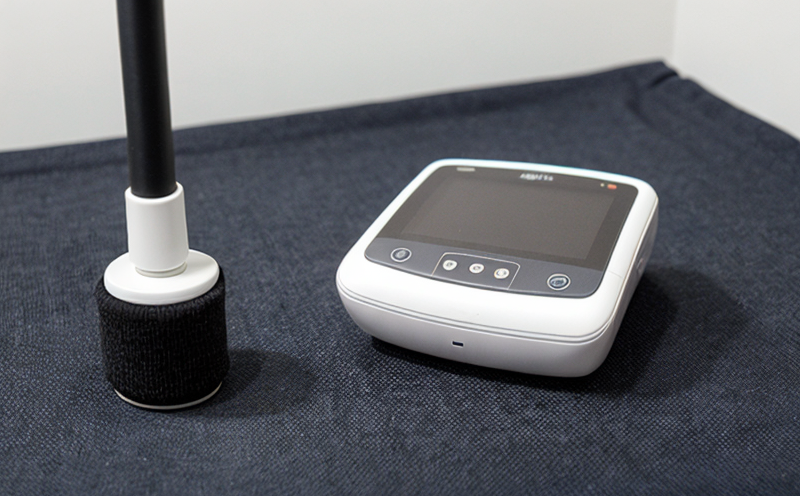Signal stability evaluation of embroidered conductive patterns
The signal stability evaluation of embroidered conductive patterns is an essential process in the textile industry. This service ensures that the electrical conductivity and performance of embroidered textiles remain consistent over time, under various environmental conditions, and during use. The test evaluates how well these materials maintain their functionality, which is critical for garments used in smart and functional applications.
The evaluation typically involves exposing the embroidered conductive patterns to different stress factors such as washing cycles, drying processes, exposure to chemicals, and mechanical stresses like stretching or folding. This ensures that the electrical properties of the textile do not degrade over time, maintaining its performance integrity.
Embroidered conductive patterns are used in various sectors including healthcare, electronics, and fashion where signal stability is crucial for the product's functionality. For instance, in medical wearables, any degradation in the conductive pattern could lead to inaccuracies in vital sign monitoring. In electronics integration within textiles, poor signal stability can result in ineffective communication or data transfer.
The evaluation process begins with a detailed assessment of the conductive materials and patterns used. The type of conductive thread, the density of embroidery, and the overall design are critical factors that influence the outcome of the test. Specimen preparation involves creating samples that mimic real-world usage conditions as closely as possible. Once prepared, these specimens undergo rigorous testing under controlled environmental conditions to simulate actual use.
The instrumentation used in this evaluation is highly sophisticated, capable of measuring electrical resistance and capacitance changes over time. This helps in identifying any shifts or degradation in the conductive properties of the embroidered patterns. The testing apparatus is designed to provide accurate measurements that can be correlated with real-world usage scenarios.
Acceptance criteria for signal stability are set according to international standards such as ISO 17456-2 and IEC 60309, ensuring consistency in test results across different laboratories. The acceptance criteria specify the acceptable levels of degradation that can be tolerated before a product is considered non-compliant with industry standards.
The importance of this service cannot be overstated, as it ensures that smart and functional textiles meet not only current but also future requirements for performance and reliability. This evaluation process allows manufacturers to identify potential issues early in the development cycle, ensuring that products are robust enough to withstand the demands placed upon them by consumers.
By conducting signal stability evaluations of embroidered conductive patterns, we provide a comprehensive service that enhances product quality and ensures compliance with international standards. Our expertise in this area enables us to deliver accurate, reliable results that can be trusted by our clients.
- Specimen Preparation: Careful preparation of specimens is crucial for obtaining accurate test results.
- Environmental Control: Maintaining controlled environmental conditions during testing ensures consistent and repeatable results.
- Instrumentation Precision: High-precision instruments are used to measure subtle changes in electrical properties.
- Compliance Assurance: Testing adheres strictly to international standards, ensuring compliance with regulatory requirements.
Industry Applications
The signal stability evaluation of embroidered conductive patterns finds applications across multiple sectors. In the healthcare industry, it ensures that wearable medical devices function correctly and consistently over time. For example, in ECG monitoring devices embedded into clothing, any degradation in the conductive pattern could lead to inaccurate readings, compromising patient care.
In electronics integration within textiles, this evaluation is vital for maintaining reliable communication and data transfer capabilities. Smart clothing with integrated sensors must remain stable under various environmental conditions to ensure accurate performance. In fashion, where innovation meets functionality, these tests help in creating products that not only look good but also perform reliably.
The aerospace sector benefits from such evaluations by ensuring that embedded conductive patterns within textiles used for space suits or other critical applications maintain their integrity during extreme environmental conditions. Similarly, the automotive industry can leverage this service to enhance safety features integrated into clothing, like seat belt tensioners or airbag deployment systems.
By focusing on these applications, our signal stability evaluation ensures that products not only meet but exceed expectations for performance and reliability. This is particularly important in sectors where failures could lead to severe consequences, from health risks to life-threatening situations.
Why Choose This Test
- Precision: Utilizing high-precision instruments for accurate measurements ensures reliable test results.
- Consistency: Strict adherence to international standards guarantees consistent and repeatable results across different laboratories.
- Compliance: Ensuring compliance with regulatory requirements enhances product safety and protects the reputation of manufacturers.
- Innovation: This service supports innovation by enabling early identification and resolution of potential issues in the development cycle.
Use Cases and Application Examples
The signal stability evaluation is applicable to a wide range of products, including but not limited to wearable medical devices, smart clothing with embedded sensors, aerospace textiles used for space suits or other critical applications, and automotive safety features integrated into clothing.
In the healthcare sector, this service ensures that ECG monitoring devices remain accurate over time. For electronics integration within textiles, it guarantees reliable communication and data transfer capabilities. In fashion, innovation meets functionality with products that not only look good but also perform reliably under various conditions.
The aerospace sector benefits from such evaluations by ensuring that embedded conductive patterns in textiles used for space suits or other critical applications maintain their integrity during extreme environmental conditions. Similarly, the automotive industry can enhance safety features integrated into clothing like seat belt tensioners or airbag deployment systems.





